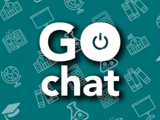Here's what you missed from our Go Online Chat!
We started with a brief discussion about several recent articles from EDUCAUSE Review that caught our attention:
- The Handoff: Transitioning from synchronous to asynchronous teaching tackled the topic of balancing live synchronous instruction with asynchronous delivery. The authors note it starts with faculty communicating to students their purpose for each and what is to be accomplished. Bottom line: know your students, know your technology because a variety of tools can support diverse learning styles.
- Play in the time of COVID-19. Faculty are encouraged to challenge existing ideas about play that can dictate it is necessary to be serious all the time. Don’t forget the benefits of play in the learning environment! Your course design is one way to remove barriers to learning, create safety and community, and support motivation and student investment. A more “playful” course could include ice-breakers throughout the class or activities that engage learning in thematic ways.
- Teacher, are you there? Being 'present' in online learning. In this COVID, remote learning time, building and maintaining learner engagement is deemed even more critical. The authors remind us of simple steps to connect and engage, encouraging faculty to show their authentic selves. This might be your home office settings, some drop-in visits from your pets, or festive background wallpaper. Remember that synchronous and asynchronous video captures body language, facial expressions, and emotion.
At UMBC, 2020 was a time of shifting on-campus programs and courses for new students to the virtual environment. Helping us understand what this meant for students, instructors, and staff was Dr. Laila Shishineh, Director of First-Year & Transfer Academic Programs in the Division of Undergraduate Academic Affairs (UAA).
In this role, she oversees several campus initiatives: Academic Transition Courses (FYS, IHU, and TRS), Summer & Winter Bridge Programs, and the Living-Learning Communities. These two categories, courses and programs, support all new students with a strong academic core and engagement opportunities.
Academic transition courses and programs are not required, yet high numbers of new students who complete these experiences share feedback that indicates value in helping students understand the academic climate, connect with other new students, and have a successful first or second semester.
The new student population at UMBC is split almost evenly between transfer students and freshmen, which drives the need to deliver courses and programs that help all new students connect with resources and staff. “When this shift happened last spring, we started like so many on campus,”Laila said. “Our core focus was how do we continue to engage new students, create a sense of connection, and make it fun and interesting.”
In a typical year, more than 500 students will take a transition course, between 300 and 400 students will participate in a Living-Learning Community, and another 60-70 will complete the Summer Bridge program. However, in the remote setting that COVID-19 required, Summer Bridge was the first program that transitioned to fully online and the number of students in the virtual environment doubled.
“We assess our programs and courses a lot,” Laila said. “For Summer Bridge, students enjoyed the opportunity that might not have been available otherwise.” For the transition courses offered fully online in fall 2020, students felt connected to the instructor, other students, and resources, but also expressed a desire to do more on campus. “Students got what they wanted,” she said, “but they were also looking for a little more on campus and we were limited in what we could offer.”
Looking ahead, there are valuable lessons learned from offering an almost completely online semester. “The LLCs might be the one place where we can go back to what we were doing,” Laila said, “and that’s the nature of LLC. But for our transition courses and programs, this opens a huge door for us. When you think about scaling these to do more in person, that’s almost impossible with limited space, but if we take what we learned this year the opportunities for hybrid or fully virtual puts us ahead of the curve because we’re solving a problem.”
Check out the full GO Chat here for the complete interview.
Our next GO Chat takes place on Friday, March 26:Matching Technology to Pedagogy with Derek Bruff, director of the Vanderbilt University Center for Teaching and a principal senior lecturer in the Vanderbilt Department of Mathematics, about research-based principles for matching technology to pedagogy.
We interviewed Derek following the March 9 book discussion of his 2019 book, Intentional Tech: Principles to Guide the Use of Educational Technology in College Teaching.
Arguing that teaching and learning goals should drive instructors’ technology use, not the other way around, Intentional Tech explores seven research-based principles for matching technology to pedagogy. We hope you will join us!
Don't miss a GO Chat! Make sure you:
Follow our Instructional Technology and DoIT myUMBC Groups
Subscribe to our Panopto Folder
Listen to us on Apple Podcasts
As always, if you have any questions about teaching, learning and technology at UMBC, please consider the following options:
PIVOT | Academic Continuity | Keep On Teaching | Student Technology Resources
Request a consult with instructional technology staff
Posted: March 10, 2021, 9:59 AM
